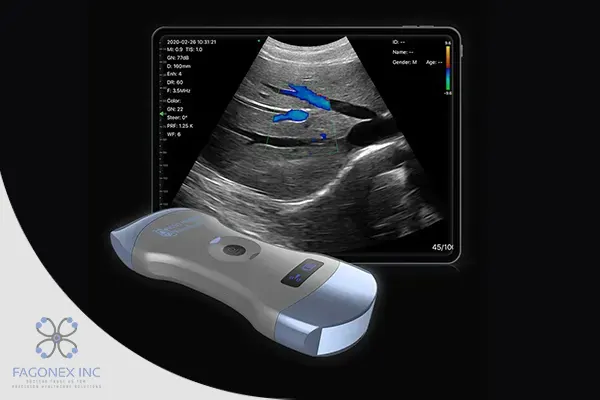Portable ultrasound machines, also known as handheld ultrasound devices, are compact, mobile medical imaging tools that offer the flexibility of performing ultrasound examinations virtually anywhere. Unlike traditional ultrasound systems that are large, stationary, and require dedicated rooms, portable ultrasound machines are designed for use at the bedside, in emergency situations, in remote areas, and even for home healthcare. These devices have revolutionized the way healthcare professionals conduct diagnostic imaging, providing real-time results and facilitating faster medical decision-making processes.
What Are Portable Ultrasound Machines
Portable ultrasound machines are medical devices that use high-frequency sound waves to produce images of the inside of the body. These devices are small, lightweight, and easy to transport, making them ideal for point-of-care diagnostics. Handheld ultrasound devices, a subset of portable ultrasounds, can be as small as a smartphone, further enhancing their convenience and usability. These machines are essential tools in various medical fields, including emergency medicine, cardiology, obstetrics, and musculoskeletal care, providing real-time imaging that aids in diagnosis and treatment.

How Does Portable Ultrasound Work
Portable ultrasound machines operate on the same basic principles as traditional ultrasound systems. They use a transducer, which emits high-frequency sound waves that penetrate the body and bounce off tissues, organs, and other structures. These reflected sound waves are then captured by the transducer and processed by the machine to create visual images. The quality and resolution of these images have significantly improved with advancements in technology, allowing portable devices to produce diagnostic-quality images comparable to those generated by larger systems.
The process begins when the transducer is placed on the skin after applying a special gel that helps transmit the sound waves into the body. The sound waves travel through the body, reflecting off different structures based on their density. The returning echoes are converted into electrical signals, which are processed to form images on a display screen. The real-time nature of ultrasound imaging makes it especially useful for dynamic studies, such as assessing blood flow or the movement of organs.
Types of Portable Ultrasound
There are several types of portable ultrasound machines, each designed to meet specific clinical needs:
Handheld Ultrasound Devices
These are the smallest and most portable, often resembling smartphones or tablets. They are highly convenient for quick assessments and are increasingly popular in point-of-care settings. These devices are particularly useful in emergency rooms, ambulances, and remote locations where immediate imaging is crucial.
Laptop-Based Ultrasound Systems
These devices are larger than handheld units but still portable. They offer more advanced features and higher image quality, making them suitable for a broader range of applications. They are commonly used in clinical settings where a balance between portability and functionality is needed.
Tablet-Based Ultrasound Systems
Combining portability with functionality, these systems are slightly larger than handheld devices but more versatile, often equipped with more extensive software and imaging capabilities. They are ideal for detailed diagnostic procedures and can be easily carried to different patient rooms or locations.

Cart-Based Portable Ultrasound Systems
Although larger and less portable than handheld or laptop-based units, these systems are designed for easy movement within a hospital or clinic. They provide the most advanced imaging features among portable options and are often used in departments where high-end imaging capabilities are required but where flexibility of movement within the facility is also important.
Benefits of Portable Ultrasound
The advantages of portable ultrasound machines are numerous and significant:
- Mobility and Flexibility: Their compact size allows healthcare providers to bring the ultrasound to the patient, which is crucial in emergency situations, rural areas, and home healthcare settings. This mobility reduces the need for patient transportation, which can be particularly beneficial for critically ill or immobile patients.
- Cost-Effective: Portable ultrasounds are generally more affordable than traditional systems, reducing the financial burden on healthcare facilities and patients. The lower cost of these devices makes them accessible to a broader range of medical practitioners, including those in low-resource settings.
- Time-Efficient: The ability to perform bedside scans reduces the need for patient transport, saving time and improving workflow efficiency in busy clinical environments. This can lead to quicker diagnoses and treatment decisions, improving overall patient care.
- Improved Patient Care Real-time imaging facilitates quicker diagnosis and treatment, enhancing patient outcomes. It also enables continuous monitoring of patients in critical care settings, allowing for immediate adjustments to treatment plans as needed.
- Versatility:These machines can be used in a wide range of medical specialties, from cardiology and obstetrics to sports medicine and veterinary care. Their adaptability makes them a valuable tool for various diagnostic and monitoring purposes.
- User-Friendly: Advances in technology have made portable ultrasound devices more intuitive and easier to use, even for practitioners who may not be specialists in ultrasound. This accessibility enhances their utility across different healthcare settings.

Future of Portable Ultrasound
The future of portable ultrasound looks promising, with ongoing advancements in technology poised to enhance their capabilities further. Innovations such as artificial intelligence (AI) integration are expected to improve diagnostic accuracy and automate some aspects of image interpretation, making these devices even more user-friendly. AI algorithms can assist in identifying abnormalities, measuring structures, and providing diagnostic suggestions, which can be particularly useful in settings where specialist radiologists are not available.
Wireless technology and cloud-based platforms are also likely to play a significant role, enabling seamless data sharing and remote consultations. This connectivity allows for telemedicine applications, where images can be transmitted to specialists for review and consultation, regardless of geographical barriers.
Moreover, as the demand for point-of-care diagnostics continues to grow, portable ultrasound machines will become increasingly indispensable in delivering high-quality, accessible healthcare across diverse settings. The continued miniaturization of components and improvements in battery life will further enhance their portability and usability. Future developments may also include more robust, durable designs suited for harsh environments, expanding their use in military, disaster relief, and other challenging scenarios.
Read More: Future of Portable Ultrasound Machines
Choosing the Right Portable Ultrasound Machine
Selecting the most suitable portable ultrasound machine involves more than just reviewing prices or brand names. It requires a thorough understanding of clinical needs, patient volume, diagnostic goals, and available resources. Whether you’re a general practitioner, emergency care provider, or veterinary specialist, the key is to find a device that aligns with your specific workflow and medical use case.
Start by defining your primary clinical applications. For instance, musculoskeletal imaging requires high-frequency linear probes, while obstetric or abdominal scans benefit from curvilinear probes. Some modern handheld devices like the Butterfly iQ+ or GE Vscan Air are equipped with multi-purpose probes, offering versatility across specialties.
Portability and battery life are essential for professionals working in the field or in dynamic clinical environments. Look for devices that offer at least 3–5 hours of battery time, quick recharging options, and a rugged, water-resistant design (IP67 or better). This ensures optimal performance in ambulances, rural clinics, and during emergency response missions.
Ease of use also plays a significant role. Devices with intuitive touchscreens, app-based controls, and AI-guided scan modes are ideal for both new users and experienced practitioners. These features can help reduce the learning curve, minimize diagnostic errors, and speed up decision-making.
Additionally, ensure that the system supports real-time image sharing and integration with electronic health records (EHR). Wi-Fi and Bluetooth connectivity, PACS compatibility, and secure cloud backups are now standard among leading brands. These tools are especially useful in telemedicine and team-based care environments, where quick access to imaging results can improve treatment timelines.
FAQ
What is a portable ultrasound machine?
A portable ultrasound machine is a compact, mobile device that uses high-frequency sound waves to create images of the inside of the body, allowing for diagnostic imaging at the point of care. These machines are designed to be easily transported and used in various healthcare settings, providing flexibility and immediate access to imaging technology.
How does a handheld ultrasound work?
Handheld ultrasound devices operate by emitting sound waves that reflect off internal structures. These reflected waves are captured and processed to produce visual images, similar to traditional ultrasound systems but on a smaller scale. The process involves a transducer, a conductive gel, and a display unit that shows the images in real-time.
What are the types of portable ultrasound machines?
Types include handheld ultrasound devices, laptop-based systems, tablet-based systems, and cart-based portable systems, each offering varying levels of portability and functionality. Handheld devices are the most portable, while cart-based systems provide the most advanced imaging features within a facility.
What are the benefits of using portable ultrasound?
Benefits include enhanced mobility, cost-effectiveness, time efficiency, improved patient care, and versatility in various medical fields. Portable ultrasounds allow for immediate imaging at the patient’s location, reducing the need for transportation and facilitating faster diagnosis and treatment.
How is portable ultrasound technology evolving?
Future advancements include AI integration for better diagnostics, wireless technology for data sharing, and continuous miniaturization and battery improvements for increased portability. These developments will enhance the functionality, accuracy, and usability of portable ultrasound devices.
Can portable ultrasound machines be used in remote areas?
Yes, their portability makes them ideal for use in remote and underserved areas, providing essential diagnostic capabilities where traditional equipment is impractical. Portable ultrasounds can be vital tools in rural healthcare, disaster relief, and military operations.
Are portable ultrasounds as accurate as traditional systems?
While traditional systems may offer higher resolution for some applications, advancements in portable ultrasound technology have significantly closed the gap, making them highly reliable for many diagnostic purposes. Improvements in transducer technology and image processing have enhanced the quality of images produced by portable devices.
What medical fields benefit from portable ultrasound?
Many fields such as emergency medicine, cardiology, obstetrics, musculoskeletal care, and even veterinary medicine benefit from the use of portable ultrasound machines. These devices are versatile and can be adapted for various diagnostic and monitoring needs across different specialties.
How are portable ultrasounds powered?
Most portable ultrasound machines are battery-powered, allowing for use in various settings without the need for a constant power supply. Some larger models may also have plug-in options, providing flexibility depending on the environment and duration of use.
Can portable ultrasound images be shared electronically?
Yes, many portable ultrasound machines have capabilities for electronic image sharing, either through direct connections or cloud-based platforms, facilitating remote consultations and collaboration. This feature is particularly valuable in telemedicine, enabling healthcare providers to seek expert opinions from specialists regardless of location.

